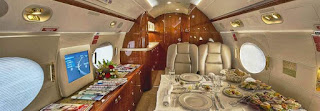https://centraljetcharter.com/learjet-31a.html
The airplane also offers good runway performance and low fuel burns.
Passenger seating is for eight—usually a three-seat divan and four individual chairs, plus a side-facing potty seat across from the entry door.
One key improvement over the Learjet 35 was installation of delta fins on the Learjet 31’s lower rear fuselage, which improved stall characteristics and eliminated the need for a stick puller/pusher system.
The Learjet 31 first flew in May 1987 and was FAA certified in August 1988. The original Learjet 31 had a maximum takeoff weight of 15,500 pounds, which was later increased to 16,500 or 17,700 pounds via supplemental type certificates.
An ER (extended range) version featured more fuel capacity, which enabled the aircraft to fly about 175 nautical miles farther.
The airplane also offers good runway performance and low fuel burns.
Passenger seating is for eight—usually a three-seat divan and four individual chairs, plus a side-facing potty seat across from the entry door.
One key improvement over the Learjet 35 was installation of delta fins on the Learjet 31’s lower rear fuselage, which improved stall characteristics and eliminated the need for a stick puller/pusher system.
The Learjet 31 first flew in May 1987 and was FAA certified in August 1988. The original Learjet 31 had a maximum takeoff weight of 15,500 pounds, which was later increased to 16,500 or 17,700 pounds via supplemental type certificates.
An ER (extended range) version featured more fuel capacity, which enabled the aircraft to fly about 175 nautical miles farther.




Comments
Post a Comment